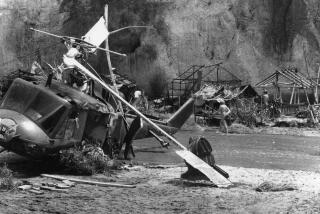‘Twilight’ Case Jury Visits Scene of Fatal Copter Crash
- Share via
Jurors in the “Twilight Zone” manslaughter trial of movie director John Landis and four colleagues took a rustic field trip Tuesday to the muddy riverbed near Saugus, where a helicopter crashed 4 1/2 years ago, killing actor Vic Morrow and two children.
The jurors and alternates, bused to the Indian Dunes Park, 35 miles north of downtown Los Angeles, stepped gingerly through mud and sand as they were led over a makeshift bridge to the spot where the helicopter nose fell on July 23, 1982. The field trip was a finale to the prosecution’s case, which took 5 1/2 months and about 70 witnesses, Deputy Dist. Atty. Lea Purwin D’Agostino said.
But before the jurors arrived, D’Agostino lost her battle to give them a demonstration of how a helicopter would look flying at the same altitude as the ill-fated chopper did just before it crashed during the filming.
Los Angeles Superior Court Judge Roger Boren watched such a demonstration with a Los Angeles County Fire Department helicopter simulating the flight path over the Indian Dunes movie location.
The chopper flew in three times, circling the area lower each time, until it hovered at about 25 feet above the Santa Clara River.
Those in the area before the jury arrived aboard a Sheriff’s Department bus--including defendants, attorneys and reporters--turned away as the chopper kicked up dust and water in its wake.
Then, in a colorful scene, Boren convened court on the river bank, with the court reporter anchoring her stenotype machine in the sand, as attorneys in blue jeans and boots argued their cases.
At one point, the croaking of bullfrogs and squawking of ducks all but drowned out voices, and the judge called for a brief pause until it was quiet.
Defense attorneys James Sanders and Leonard Levine vehemently opposed the helicopter demonstration, saying that it would not exactly duplicate the original situation, would not include special-effects explosions and would give jurors the impression that it was too dangerous to repeat the actual scene.
“I’m going to disallow the helicopter,” Boren said without explaining why.
The judge already had rejected D’Agostino’s original proposal to have explosives detonated in a duplication of the Vietnam War movie scene which ended in real-life tragedy.
When jurors arrived, there was no helicopter in sight and the scene was still.
But in the early morning hours of July 23, 1982, a helicopter flew through fiery special effects explosions, went into a spin and crashed on top of Morrow, 53, Myca Le, 7, and Renee Chen, 6.
Landis, who was directing the scene, was charged with involuntary manslaughter, along with associate producer George Folsey Jr., production manager Dan Allingham, special effects coordinator Paul Stewart and pilot Dorcey Wingo.
During Tuesday’s visit, jurors and alternates were led out to a small peninsula, where they were given pictures and diagrams of the crash scene to compare with the real thing.
“This is the spot where the nose of the helicopter was after the crash,” court bailiff Larry Brezeale pointed out.
Jurors spent about 35 minutes trudging around the scene and comparing pictures. At times they seemed confused and conferred with each other on where certain items were located.
After they had climbed back into the bus and left the scene, D’Agostino told reporters that she was “tremendously disappointed” that the helicopter demonstration had been banned.
But she said it was important for jurors to see the spatial relationships of the scenery which they had heard about in testimony and seen on films of the accident.
“When you see the film, this place looks a lot larger than it does in person,” she said. “The smallness is truly awesome.”
She noted that a cliff that looms over the scene appears much closer to the shore than it does on film, adding, “It makes it seem even more dangerous.”
But defense attorney Harland Braun insisted that the scene seemed larger to him in life than it did on film.
“The jurors could see the massive size of the area and they could see that the scene could be shot safely,” he said.
As the prosecution’s case wound up, defense attorneys refused to disclose their plans for the defense presentation. Landis’ attorney, James Neal, claimed that the defense had not yet decided whether it will be necessary to put on evidence to refute a prosecution case he sees as weak.
More to Read
Sign up for Essential California
The most important California stories and recommendations in your inbox every morning.
You may occasionally receive promotional content from the Los Angeles Times.










